The Schefflera arboricola [shef-LER-uh ar-bor-ee-KO-luh] or dwarf umbrella bush is a broad-leaved evergreen shrub belonging to the family Araliaceae and hailing from Taiwan and Hainan.
The plant’s genus name honors Polish 19th-century botanist Jacob Christoph Scheffler. The specific epithet, arboricola, is derived from Latin and means tree-like.

Common names for this plant include:
- Hawaiian Dwarf Umbrella tree
- Dwarf Hawaiian Schefflera
- Australian Ivy Palm
- Dwarf Arboricola plant
- Umbrella bush
- Octopus Tree
- Parasol plant
- Starleaf’
- Queensland umbrella tree
When colorful annuals make their way into garden centers, spring foliage indoor plants like the dwarf Hawaiian umbrella bush – Schefflera Arboricola- also arrive!
In most garden centers, you’ll find arboricola in the regular “mix” of tropical plants, filling out many of the spring indoor house plant assortments.
The Arboricola Schefflera is the “dwarf” cousin to the old-time umbrella – Schefflera actinophylla.
You’ll find quite a few arboricola varieties in most garden centers or nurseries.
Below are some of the Dwarf Hawaiian variegated Schefflera varieties commonly found today:
- Arboricola – regular green variety
- Renate Green variety that has more ripple to the leaves
- ‘Gold Capella’ variegated green, gold, or yellow leaves
- ‘Trinette’ variegated cream and green leaves
- ‘Dazzle’ variegated some leaves almost completely creamy white
New Arboricola cultivars are introduced each year.

Schefflera Plant Quick Care Tips
- Botanical Name: Schefflera arboricola
- Common Name(s): Dwarf Umbrella plant, Dwarf Schefflera
- Synonyms: Heptapleurum arboricolum, Brassaia arboricola
- Family & Origin: Araliaceae family, native to Taiwan and Hainan
- Growability: Easy to grow
- Grow Zone: 10-12
- Size: Grows up to 10-15′ feet tall, but usually kept smaller as a houseplant, about 5-6′ feet tall
- Flowering: Rarely flowers indoors
- Light: Bright, indirect light
- Humidity: Prefers higher humidity but can tolerate lower levels
- Temperature: Average room temperature; avoid cold drafts
- Soil: Well-draining potting soil
- Water: Water when the top inch of soil is dry, do not overwater
- Fertilizer: Fertilize every 2-3 months with a balanced fertilizer
- Pests & Diseases: Susceptible to spider mites, mealybugs, and scale insects. Root rot can also be affected by overwatering.
- Propagation: Propagated through stem cuttings or air layering
- Plant Uses: Popular houseplants can be used as decorative accents in homes and offices. Can also be used in landscaping as a shrub or small tree.
Dwarf Umbrella Schefflera Plant Care
Size & Growth Of The Tree That Looks Like An Umbrella
When grown in their native climate, these dwarf trees can actually grow to reach 10’ to 15’ feet tall.
When growing in the wild, dwarf Hawaiian Schefflera trees also grow as epiphytes with aerial roots on the bark of other trees.
When kept as a houseplant, the arboricola tree usually tops out at about 5’ – 6’ feet fall. Three feet high is more typical.
Flowering
During the summertime, the Schefflera plant produces very small red flowers that grow on compound panicles.
These transition into rounded, orange, or red drupes, which turn black as they mature.
Flowering is common on umbrella plants outdoors in the ground. Dwarf umbrellas kept indoors seldom flower.
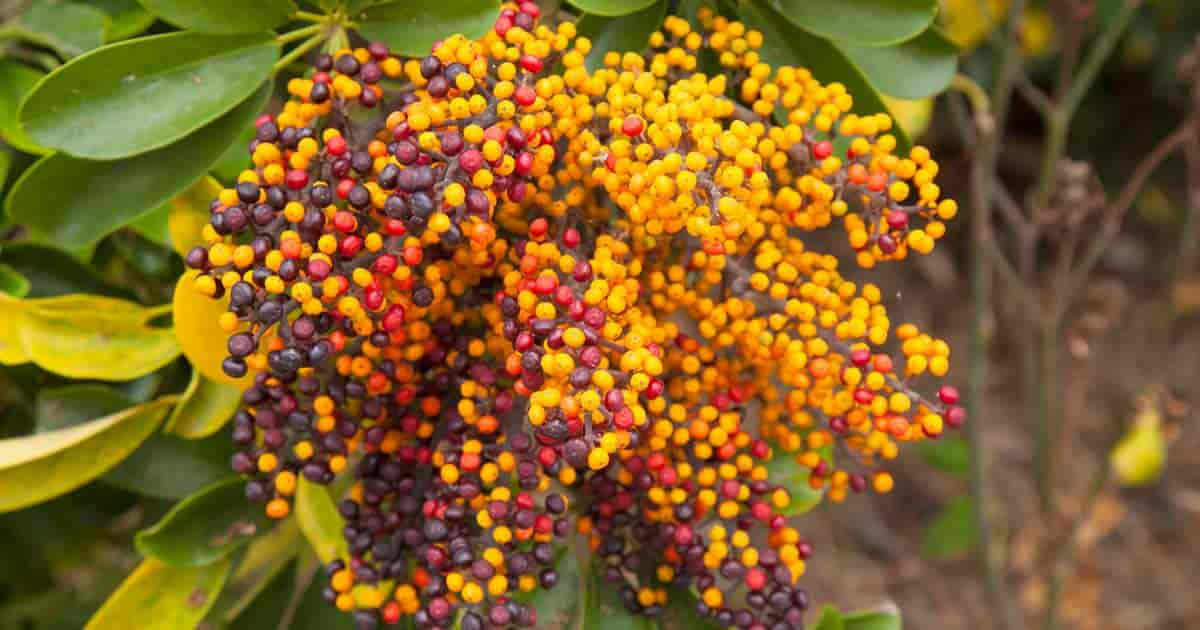
Foliage
The oblong leaves of the dwarf umbrella arboricola may grow to be 4″ to 6″ inches long individually.
The dark green leaves grow in round clusters of 7 to 9 individual leaflets, arranged in a circular fashion that mimics the spokes of an umbrella.
Light and Temperature
The arboricola plant is winter hardy in USDA hardiness zones 10 through 12.
The Schefflera arboricola can adapt to a wide variety of light levels but prefers a bright light intensity if possible, especially the variegated varieties – ‘Gold Capella’ & ‘Trinette plants.’
Dwarf Hawaiian Schefflera plants should be placed in a sheltered location with bright indirect light and medium-light shade.
Outdoors, Dwarf arboricola trees can tolerate full sun but will do better with protection from harsh, punishing midday and afternoon sun.
The Umbrella Plant cannot tolerate being outdoors in cold winter weather and should be kept as a houseplant during this time.
In the summertime, you can move your container plants outside to a sheltered location with bright, partial shade.
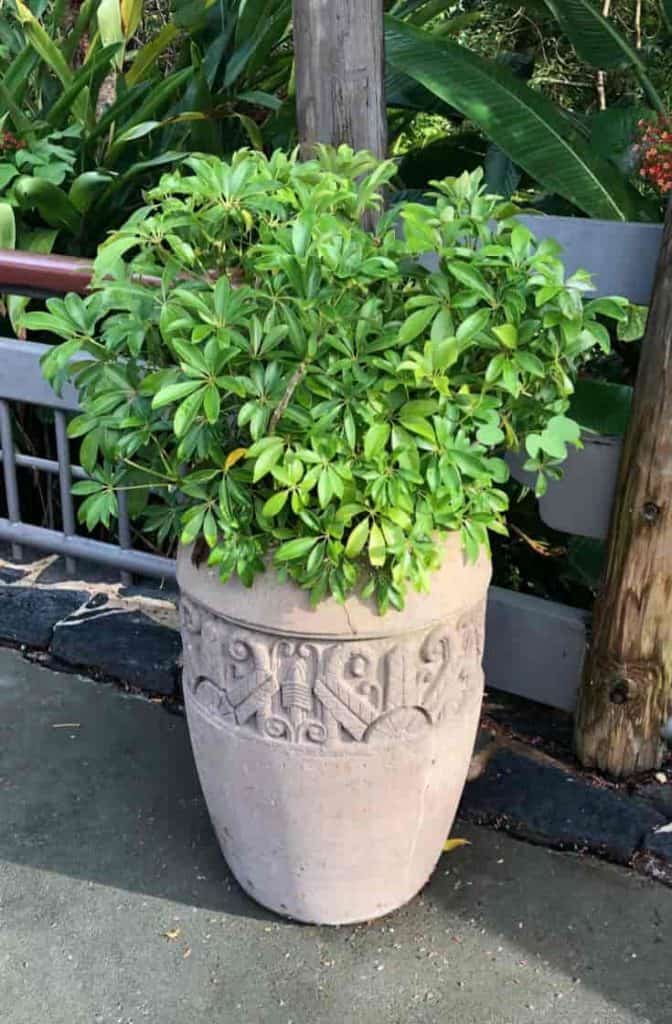
As a great houseplant, the umbrella plant is well-placed in a southern, western, or eastern window receiving curtain-filtered light for three or four hours daily.
Avoid direct sun exposure for the Schefflera houseplant.
When kept indoors, do not allow the temperature surrounding the plant to drop below 55° degrees Fahrenheit throughout the wintertime.
Keep household humidity high surrounding the plant by misting the foliage and by setting the container on a tray containing wet pebbles.
Watering and Feeding
Hawaiian umbrella trees have an extensive root system and even grow climbing a tree. They also seek water when grown outside.
As with most plants grown as a houseplant indoors, dwarf tree Schefflera arboricola does not like to sit in water, so make sure the pot has drainage holes.
Avoid letting the arboricola bush sit in a saucer of water! Make sure to discard any excess water.
Dwarf Scheff’s like moist soil but not wet. Wet soil promotes disease.
During the growing season (Spring and Summer), keep your Dwarf Hawaiian Schefflera well-watered, but avoid overwatering.
Water deeply and then allow the soil to almost dry out before watering again.
From late in the autumn until early in the spring, you should reduce watering.
Fertilizer is optional, but giving the plant a half dose of a water-soluble fertilizer once per month during the growing season helps maintain color.
Soil and Transplanting
In all climates, the Schefflera plant does well as a container plant. Provide high humidity and a well-drained potting mix with extra peat moss when used as a houseplant.
Repot in the springtime if the plant is rootbound. Do not fertilize for several weeks after repotting. With fresh soil, your Schefflera will not need fertilizer.
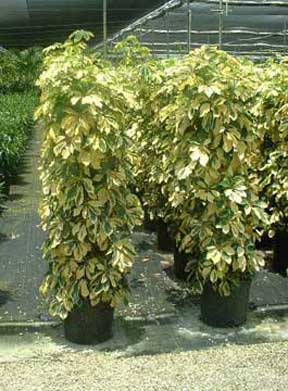
Related: Details on Repotting and Transplanting Schefflera plants
Grooming and Maintenance
Houseplants collect dust on their leaves, and the arboricola bush is no different. Clean the leaves periodically using a damp sponge.
Don’t forget the undersides, where mites like to hang out.
More on How To Clean House Plant Leaves
Prune dwarf Schefflera plants to maintain size and shape.
If left alone, the branches and stems can stretch, become leggy and grow “out of shape.” It’s easy to keep them shaped with selective pruning.
Like a Ficus tree, dwarf arboricolas can handle some radical pruning and come back strongly.
Don’t be afraid to prune the plant when needed.
Occasional yellowing of the leaves is normal. Remove yellow leaves when they appear.
NOTE: Remember, when plants move indoors, they go through a period of acclimation. Expect the plant to thin out and lose leaves while acclimating.
Related: Schefflera Amate Growing and Care
Schefflera Umbrella Plant Propagation – How To
Propagate Dwarf umbrella plants from seeds, cuttings, or by layering.
Plants will grow from seeds, but most house plants never flower or seed.
Propagating from Cuttings
- Take stem cuttings near the base of the plant. It should be about 4” – 6” inches long.
- Cut the leaves on the cutting in half, crosswise, to help reduce dehydration.
- Dip the cut end of the Scheff cutting into rooting hormone powder
- Place the cutting in a 4” inch pot of clean, well-drained potting soil.
- The end of the cutting should be buried two inches deep.
- Water and place the potted cutting in a warm, airy location with bright, indirect light.
- Keep the soil slightly damp.
- New roots begin to develop within a couple of weeks.
Propagating By Layering
- Bend a flexible, low stem into a pot of new soil placed next to the parent plant.
- Bury it slightly, and anchor it in place with a rock or similar weight.
- Keep the soil slightly moist.
- The bent stem should produce roots and start to send out new shoots within a couple of weeks.
- Once rooted, cut the stem loose from the parent plant.
More on air layering propagation
Umbrella Schefflera Pest or Diseases
The Dwarf Umbrella Plant experiences very few diseases and pest problems.
However, the Schefflera is in the Aralia family, and like many of the plants from this family, spider mites prefer these plants, especially in indoor conditions.

As with most plants, overwatering and poor conditions will cause problems with root rot.
Compromised plants are susceptible to attacks and infestation by:
- Thrips
- Aphids
- Spider mites
- Schefflera mealybugs
- Scale Insects – Look for honeydew on plants with sticky leaves!
Related: More on Natural Pest Control for Plants.
Schefflera Dropping Leaves
If leaves turn black and begin dropping off, it’s a good signal of overwatering. The soil is staying too wet or moist.
On the flip side, when leaf tips wrinkle, lower leaves wilt and wither, indicating that you are not watering enough.
Is Schefflera Considered Toxic or Poisonous to People, Kids, and Pets?
According to the ASPCA, the arboricola Schefflera is toxic to cats and dogs because the sap contains calcium oxalate crystals.
When handling the plant, wear gloves, as some people may experience skin irritation.
An animal or person who ingests the plant may experience difficulty swallowing, burning and irritation in the mouth, excessive drooling, and vomiting.
Are Arboricola Trees Considered Invasive?
Schefflera can be invasive in areas where it is winter hardy, such as Hawaii and Florida.
If you plant Schefflera (dwarf) outdoors in an area where it is winter hardy, take care to keep its spread under control.
Suggested Uses For Arboricola Schefflera
The Dwarf umbrella is an attractive, easy-care houseplant in any climate.
In areas where the plant is winter hardy, it can be used as a:
- Container plants – most found in the garden center are bush form.
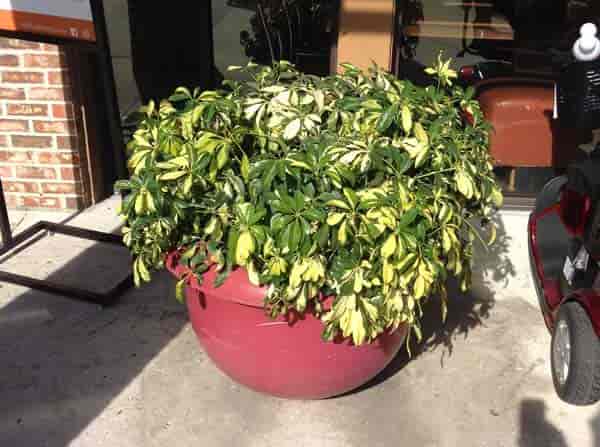
variegated umbrella gold capella bush growing in a bowl at Disney Springs, Orlando
- Plant Schefflera as a hedge
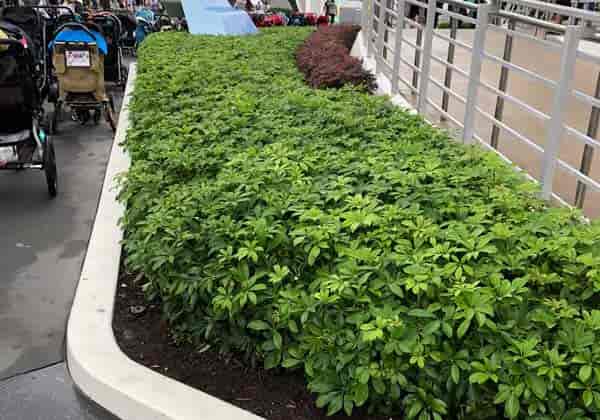
Arboricola hedge growing at Disney Magic Kingdom – Tomorrowland
- Single accent or specimen plant in the garden
- Trained as a bonsai plant
- Grow Schefflera and prune into a small tree with a single trunk or braided
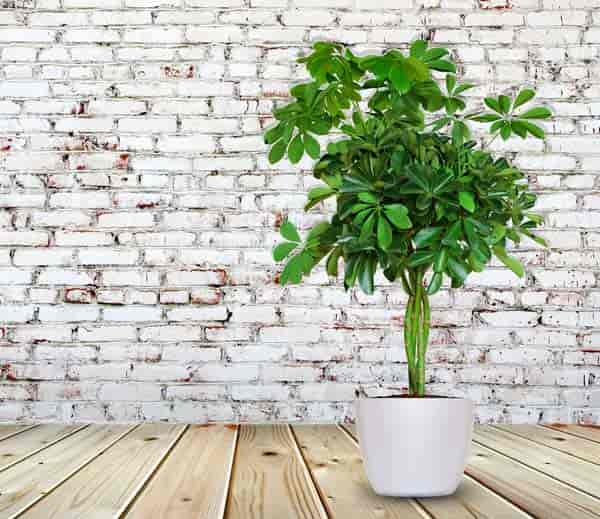
Remember with your dwarf umbrella / Schefflera plant:
- Don’t keep the plant wet
- Place the plant in an area with bright light or filtered indirect light. These are bright-light houseplants.
- Watch out for mites
- Don’t be afraid to prune when needed
That’s a quick look at Schefflera houseplants, one of the easiest to care for and popular houseplants or office plants on the market.
Schefflera/Umbrella trees will live for years when cared for properly.
